A Chronic Longitudinal Characterization of Neurobehavioral and Neuropathological Cognitive Impairment in a Mouse Model of Gulf War Agent Exposure
- PMID: 26793076
- PMCID: PMC4709860
- DOI: 10.3389/fnint.2015.00071
A Chronic Longitudinal Characterization of Neurobehavioral and Neuropathological Cognitive Impairment in a Mouse Model of Gulf War Agent Exposure
Abstract
Gulf War Illness (GWI) is a chronic multisymptom illness with a central nervous system component that includes memory impairment as well as neurological and musculoskeletal deficits. Previous studies have shown that in the First Persian Gulf War conflict (1990-1991) exposure to Gulf War (GW) agents, such as pyridostigmine bromide (PB) and permethrin (PER), were key contributors to the etiology of GWI. For this study, we used our previously established mouse model of GW agent exposure (10 days PB+PER) and undertook an extensive lifelong neurobehavioral characterization of the mice from 11 days to 22.5 months post exposure in order to address the persistence and chronicity of effects suffered by the current GWI patient population, 24 years post-exposure. Mice were evaluated using a battery of neurobehavioral testing paradigms, including Open Field Test (OFT), Elevated Plus Maze (EPM), Three Chamber Testing, Radial Arm Water Maze (RAWM), and Barnes Maze (BM) Test. We also carried out neuropathological analyses at 22.5 months post exposure to GW agents after the final behavioral testing. Our results demonstrate that PB+PER exposed mice exhibit neurobehavioral deficits beginning at the 13 months post exposure time point and continuing trends through the 22.5 month post exposure time point. Furthermore, neuropathological changes, including an increase in GFAP staining in the cerebral cortices of exposed mice, were noted 22.5 months post exposure. Thus, the persistent neuroinflammation evident in our model presents a platform with which to identify novel biological pathways, correlating with emergent outcomes that may be amenable to therapeutic targeting. Furthermore, in this work we confirmed our previous findings that GW agent exposure causes neuropathological changes, and have presented novel data which demonstrate increased disinhibition, and lack of social preference in PB+PER exposed mice at 13 months after exposure. We also extended upon our previous work to cover the lifespan of the laboratory mouse using a battery of neurobehavioral techniques.
Keywords: Gulf War; mouse model; neurobehavior; neuropathology; permethrin (PER); pyridostigmine bromide (PB).
Figures

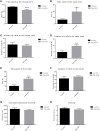





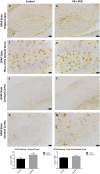
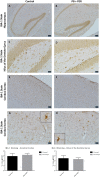

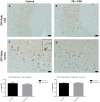
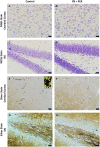
Similar articles
-
Gulf War agent exposure causes impairment of long-term memory formation and neuropathological changes in a mouse model of Gulf War Illness.PLoS One. 2015 Mar 18;10(3):e0119579. doi: 10.1371/journal.pone.0119579. eCollection 2015. PLoS One. 2015. PMID: 25785457 Free PMC article.
-
Chronic elevation of phosphocholine containing lipids in mice exposed to Gulf War agents pyridostigmine bromide and permethrin.Neurotoxicol Teratol. 2013 Nov-Dec;40:74-84. doi: 10.1016/j.ntt.2013.10.002. Epub 2013 Oct 17. Neurotoxicol Teratol. 2013. PMID: 24140745
-
Delayed treatment with the immunotherapeutic LNFPIII ameliorates multiple neurological deficits in a pesticide-nerve agent prophylactic mouse model of Gulf War Illness.Neurotoxicol Teratol. 2021 Sep-Oct;87:107012. doi: 10.1016/j.ntt.2021.107012. Epub 2021 Jul 10. Neurotoxicol Teratol. 2021. PMID: 34256162
-
Dysregulation of cellular energetics in Gulf War Illness.Toxicology. 2021 Sep;461:152894. doi: 10.1016/j.tox.2021.152894. Epub 2021 Aug 10. Toxicology. 2021. PMID: 34389359 Review.
-
A review of pre-clinical models for Gulf War Illness.Pharmacol Ther. 2021 Dec;228:107936. doi: 10.1016/j.pharmthera.2021.107936. Epub 2021 Jun 22. Pharmacol Ther. 2021. PMID: 34171340 Review.
Cited by
-
Exposing the latent phenotype of Gulf War Illness: examination of the mechanistic mediators of cognitive dysfunction.Front Immunol. 2024 Jun 11;15:1403574. doi: 10.3389/fimmu.2024.1403574. eCollection 2024. Front Immunol. 2024. PMID: 38919622 Free PMC article. Review.
-
Chronic Oxidative Stress, Mitochondrial Dysfunction, Nrf2 Activation and Inflammation in the Hippocampus Accompany Heightened Systemic Inflammation and Oxidative Stress in an Animal Model of Gulf War Illness.Front Mol Neurosci. 2017 Jun 14;10:182. doi: 10.3389/fnmol.2017.00182. eCollection 2017. Front Mol Neurosci. 2017. PMID: 28659758 Free PMC article.
-
Obesity Worsens Gulf War Illness Symptom Persistence Pathology by Linking Altered Gut Microbiome Species to Long-Term Gastrointestinal, Hepatic, and Neuronal Inflammation in a Mouse Model.Nutrients. 2020 Sep 10;12(9):2764. doi: 10.3390/nu12092764. Nutrients. 2020. PMID: 32927823 Free PMC article.
-
Endocrine disruptors also function as nervous disruptors and can be renamed endocrine and nervous disruptors (ENDs).Toxicol Rep. 2021 Jul 31;8:1538-1557. doi: 10.1016/j.toxrep.2021.07.014. eCollection 2021. Toxicol Rep. 2021. PMID: 34430217 Free PMC article. Review.
-
MMP9 modulation improves specific neurobehavioral deficits in a mouse model of Alzheimer's disease.BMC Neurosci. 2021 May 25;22(1):39. doi: 10.1186/s12868-021-00643-2. BMC Neurosci. 2021. PMID: 34034683 Free PMC article.
References
-
- Abdel-Rahman A., Abou-Donia S., El-Masry E., Shetty A., Abou-Donia M. (2004). Stress and combined exposure to low doses of pyridostigmine bromide, DEET, and permethrin produce neurochemical and neuropathological alterations in cerebral cortex, hippocampus, and cerebellum. J. Toxicol. Environ. Health A 67, 163–192. 10.1080/15287390490264802 - DOI - PubMed
-
- Abdollahi M., Ranjbar A., Shadnia S., Nikfar S., Rezaie A. (2004). Pesticides and oxidative stress: a review. Med. Sci. Monit. 10, RA141–RA147. - PubMed
-
- Abdullah L., Evans J. E., Bishop A., Reed J. M., Crynen G., Phillips J., et al. . (2012). Lipidomic profiling of phosphocholine-containing brain lipids in mice with sensorimotor deficits and anxiety-like features after exposure to Gulf War agents. Neuromolecular Med. 14, 349–361. 10.1007/s12017-012-8192-z - DOI - PubMed
LinkOut - more resources
Full Text Sources
Other Literature Sources
Miscellaneous

